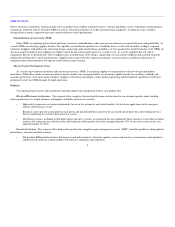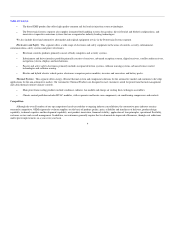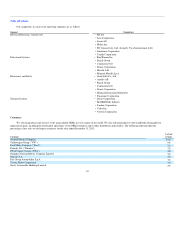DELPHI 2011 Annual Report Download - page 19
Download and view the complete annual report
Please find page 19 of the 2011 DELPHI annual report below. You can navigate through the pages in the report by either clicking on the pages listed below, or by using the keyword search tool below to find specific information within the annual report.
Table of Contents
are adversely affected by these factors, we may be similarly affected to the extent that our customers reduce the volume of orders for our products. As a result
of changes impacting our customers, sales mix can shift which may have either favorable or unfavorable impact on revenue and would include shifts in
regional growth, shifts in OEM sales demand, as well as shifts in consumer demand related to vehicle segment purchases and content penetration. For
instance, a shift in sales demand favoring a particular OEM's vehicle model for which we do not have a supply contract may negatively impact our revenue. A
shift in regional sales demand toward certain markets could favorably impact the sales of those of our customers that have a large market share in those
regions, which in turn would be expected to have a favorable impact on our revenue.
The mix of vehicle offerings by our OEM customers also impacts our sales. A decrease in consumer demand for specific types of vehicles where we
have traditionally provided significant content could have a significant effect on our business and financial condition. Our sales of products in the regions in
which our customers operate also depend on the success of these customers in those regions.
Declines in the market share or business of Daimler, Ford, GM, PSA and VW may have a disproportionate adverse impact on our revenues and
profitability.
Daimler, Ford, GM, PSA and VW accounted for approximately 47% of our total net sales in the year ended December 31, 2011. Accordingly, our
revenues may be disproportionately affected by decreases in any of their businesses or market share. Because our customers typically have no obligation to
purchase a specific quantity of parts, a decline in the production levels of any of our major customers, particularly with respect to models for which we are a
significant supplier, could disproportionately reduce our sales and thereby adversely affect our financial condition, operating results and cash flows. See
Item 1. Supply Relationships with Our Customers.
Continued pricing pressures, OEM cost reduction initiatives and the ability of OEMs to re-source or cancel vehicle programs may result in lower than
anticipated margins, or losses, which may have a significant negative impact on our business.
Cost-cutting initiatives adopted by our customers result in increased downward pressure on pricing. Our customer supply agreements generally require
step-downs in component pricing over the period of production, typically one to two percent per year. In addition, our customers often reserve the right to
terminate their supply contracts for convenience, which enhances their ability to obtain price reductions. OEMs have also possessed significant leverage over
their suppliers, including us, because the automotive component supply industry is highly competitive, serves a limited number of customers, has a high fixed
cost base and historically has had excess capacity. Based on these factors, and the fact that our customers' product programs typically last a number of years
and are anticipated to encompass large volumes, our customers are able to negotiate favorable pricing. Accordingly, as a Tier I supplier, we are subject to
substantial continuing pressure from OEMs to reduce the price of our products. It is possible that pricing pressures beyond our expectations could intensify as
OEMs pursue restructuring and cost cutting initiatives. If we are unable to generate sufficient production cost savings in the future to offset price reductions,
our gross margin and profitability would be adversely affected. See Item 1. Supply Relationships with Our Customers for a detailed discussion of our supply
agreements with our customers.
Our supply agreements with our OEM customers are generally requirements contracts, and a decline in the production requirements of any of our
customers, and in particular our largest customers, could adversely impact our revenues and profitability.
We receive OEM purchase orders for specific components supplied for particular vehicles. In most instances our OEM customers agree to purchase
their requirements for specific products but are not required to purchase any minimum amount of products from us. The contracts we have entered into with
most of our customers have terms ranging from one year to the life of the model (usually three to seven years, although customers often reserve the right to
terminate for convenience). Therefore, a significant decrease in demand for certain key models or group of related models sold by any of our major customers
or the ability of a manufacturer to re-source and discontinue purchasing from us, for a particular model or group of models, could
18
























